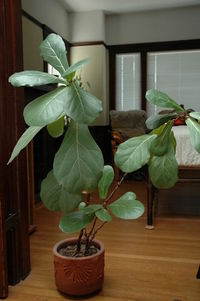Ficus lyrata: Difference between revisions
No edit summary |
No edit summary |
||
| Line 3: | Line 3: | ||
|genus=Ficus | |genus=Ficus | ||
|species=lyrata | |species=lyrata | ||
|common_name=fiddle-leaf fig | |||
|habit=tree | |habit=tree | ||
|habit_ref=Flora - A Gardener's Encyclopedia ISBN 0881925381 | |habit_ref=Flora - A Gardener's Encyclopedia ISBN 0881925381 | ||
| Line 19: | Line 20: | ||
|usda_ref=Flora - A Gardener's Encyclopedia ISBN 0881925381 | |usda_ref=Flora - A Gardener's Encyclopedia ISBN 0881925381 | ||
|max_zone=12 | |max_zone=12 | ||
|image=DSC_0504.JPG | |||
|image_width=200 | |||
| image = DSC_0504.JPG | |||
| image_width = | |||
}} | }} | ||
'''''Ficus lyrata''''', commonly known as the '''fiddle-leaf fig''', is a species of [[Ficus|fig]] tree, native to western [[Africa]], from [[Cameroon]] west to [[Sierra Leone]]. It grows in lowland tropical [[rainforest]]. | |||
It is a [[banyan]] fig (''Ficus'' subgenus ''Urostigma'') that commonly starts life as an [[epiphyte]] high in the crown of another tree; it then sends roots down to the ground which envelop the trunk of the host tree and slowly strangles it. It can also grow as a free-standing tree on its own, growing up to 12-15 m (40-50 ft) tall. The [[leaf|leaves]] are variable in shape, but often with a broad apex and narrow middle, resembling a [[fiddle]]; they are up to {{convert|45|cm|in|abbr=on|0}} long and {{convert|30|cm|in|abbr=on|0}} broad, though usually smaller, with a leathery texture and a wavy margin. The [[fruit]] is a green fig 2.5-3 cm (1-¼ in) diameter. | |||
It is a popular [[ornamental tree]] in subtropical and tropical gardens, and is also grown as a [[houseplant]], where it usually stays shorter when put into pots than when grown outdoors. Their main horticultural feature are their large leaves. Like other fig species, it can grow to a large tree if planted in the ground. Like all figs, it is frost tender. | |||
==Cultivation== | |||
===Propagation=== | |||
===Pests and diseases=== | |||
==Varieties== | |||
==Gallery== | |||
<gallery perrow=5> | |||
Image:Upload.png| photo 1 | |||
Image:Upload.png| photo 2 | |||
Image:Upload.png| photo 3 | |||
</gallery> | |||
== | ==References== | ||
<references/> | |||
<!--- xxxxx *Flora: The Gardener's Bible, by Sean Hogan. Global Book Publishing, 2003. ISBN 0881925381 --> | |||
<!--- xxxxx *American Horticultural Society: A-Z Encyclopedia of Garden Plants, by Christopher Brickell, Judith D. Zuk. 1996. ISBN 0789419432 --> | |||
<!--- xxxxx *Sunset National Garden Book. Sunset Books, Inc., 1997. ISBN 0376038608 --> | |||
==External links== | ==External links== | ||
* | *{{wplink}} | ||
{{stub}} | |||
{{ | __NOTOC__ | ||
Latest revision as of 17:26, 26 July 2010
| Ficus lyrata subsp. var. | fiddle-leaf fig | |||||||||||||||||||||||||||||||||||||||||||||||||||||||
|---|---|---|---|---|---|---|---|---|---|---|---|---|---|---|---|---|---|---|---|---|---|---|---|---|---|---|---|---|---|---|---|---|---|---|---|---|---|---|---|---|---|---|---|---|---|---|---|---|---|---|---|---|---|---|---|---|

|
|
| ||||||||||||||||||||||||||||||||||||||||||||||||||||||
| ||||||||||||||||||||||||||||||||||||||||||||||||||||||||
Ficus lyrata, commonly known as the fiddle-leaf fig, is a species of fig tree, native to western Africa, from Cameroon west to Sierra Leone. It grows in lowland tropical rainforest.
It is a banyan fig (Ficus subgenus Urostigma) that commonly starts life as an epiphyte high in the crown of another tree; it then sends roots down to the ground which envelop the trunk of the host tree and slowly strangles it. It can also grow as a free-standing tree on its own, growing up to 12-15 m (40-50 ft) tall. The leaves are variable in shape, but often with a broad apex and narrow middle, resembling a fiddle; they are up to 45 cm in 0 long and 30 cm in 0 broad, though usually smaller, with a leathery texture and a wavy margin. The fruit is a green fig 2.5-3 cm (1-¼ in) diameter.
It is a popular ornamental tree in subtropical and tropical gardens, and is also grown as a houseplant, where it usually stays shorter when put into pots than when grown outdoors. Their main horticultural feature are their large leaves. Like other fig species, it can grow to a large tree if planted in the ground. Like all figs, it is frost tender.
Cultivation
Propagation
Pests and diseases
Varieties
Gallery
-
photo 1
-
photo 2
-
photo 3
References
External links
- w:Ficus lyrata. Some of the material on this page may be from Wikipedia, under the Creative Commons license.
- Ficus lyrata QR Code (Size 50, 100, 200, 500)
